How to Take a Real Vacation While Running Your Own Business
With my Central American vacation extravaganza coming up tomorrow (gulp!) , I've been experiencing a higher than usual degree of anxiety around my business. This will be the first time that I'll really be "away" from my work in any real capacity, and I'm starting to realize why only 9% of the 200 business owners interviewed in a survey by OnDeck allowed themselves to take a full two-week vacatio.
This is really distressing news! Relaxing and taking a break is crucial to being productive and happy, and it provides much-needed downtime away from all the screens and stresses of everyday life. Even better, with recent advances in technology business owners can work from virtually anywhere, meaning that they can check in and give themselves peace of mind that their hard work isn't crumbling to pieces while they're on the beach.
However, in order to go away on a vacation and not lose your mind, there are a few steps that you can take to help alleviate anxiety and keep things running properly while you're away. Here are some which have helped me:
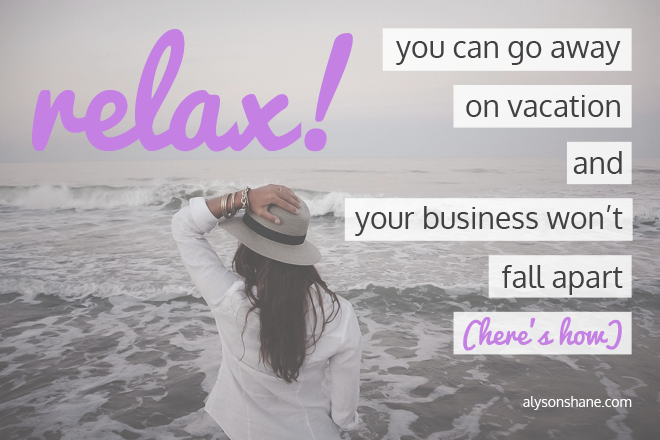
1. Have someone you trust step in for you
If you manage a business with a few employees, then speak to one of them about handling some of your more pressing duties. Having someone that you trust, whom you know can handle themselves in a crisis and won't burn your business to the (figurative) ground will go a long way towards making sure you aren't stressing out the entire time you're gone.
In my case, I'm getting someone I trust to handle my client's accounts while I'm away. I've planned out as much content in advance as I can, and made my clients aware of a very strict cutoff date for info pertaining to pressing ads and marketing campaigns, so that way all that person has to do is a bit of community management (ie: replying to Tweets and comments as needed).
2. Communicate your expectations
If you run a service-based business like I do, communication is key. This is great day-to-day advice, but is especially applicable when you're about to go away on vacation. Keeping your clients or customers in the loop goes a long way towards building trusting relationships, and helps set their expectations as to what you can reasonably do while you're away.
To illustrate: last week after the holidays ended I sent all of my clients an email with a friendly post-holiday message, and a reminder that I'm going out of town. Now they know the exact dates I'm leaving and returning, as well as the final submission date for any content they need created or scheduled. I also asked them to think of any upcoming events or promotional opportunities, and to let me know ASAP so I that I can plan ahead to make sure nothing gets missed.
I also let them know that, while I will be checking my email from time to time, I'll be in the jungles (or beaches!) of Central America and have no idea what the wifi will be like, so it may take me a few days to respond. By communicating expectations in advance, both parties know what to expect.
If you have employees, make them aware of what you expect them to do while you're away. Having a checklist or defined list of tasks and goals can go a long way towards helping them stay motivated in your absence, and defines clear expectations so there's no confusion.
3. Set boundaries
The point of a vacation is to peel yourself away from your screen.
As someone who literally makes their living online, I know that I'm going to struggle to not keep my face buried in my iPhone screen the entire time, and honestly this is giving me some anxiety.
I'm lucky that a lot of the places we're going will probably have pretty slow, spotty wifi, which will help force me off my phone, but if you're going somewhere with a strong connection, like a resort or somewhere that isn't in the middle of the Guatemalan jungle, then setting rules like "I only check my email in the morning over coffee" can go a long way to keeping you sane.
Not just that, but having a rule for when you "check in" can also help your clients and employees (if you have them) know when to expect to hear from you, and when the best time to get in touch with you will be.
4. Use collaboration tools & group chats
There are a variety of collaboration tools online such as Slack, Asana, Evernote, BaseCamp, and Trello (my personal fave) which you can use to stay in the loop about various projects and opportunities. By making the most of these tools you can communicate and catch up with your team or clients quickly and effectively, leaving more time to hang out and relax.
In the event of a crisis, tools like Google Hangouts and Skype are great for having a quick chat to solve the problem. This can work great for employees who are stressed out during a crisis, or a client who is having a meltdown while you're on another continent.
How do you keep from going crazy when you go away on vacation? Tell me in the comments!
How to Create a Value Proposition That Stands Out From the Crowd
One of the cornerstones to running a successful business is having a strong value proposition.
Not sure what the heck a "value proposition" is? Here's a breakdown:
- It explains how your product or service solves your clients’ problems
- It highlights specific benefits of working with you
- Explains why working with you is a better option than working with your competitors
Understanding these three key things can go a long way towards building your business, helping you find and retain the kinds of clients and customers you want, and goes a long way towards quoting accurately and not selling yourself short (which many people I meet tend to do, it seems).
Despite it's importance, many of the people I've met either don't know how to create one, or don't understand the steps to creating an effective one which helps their business forward.
Today, we're going to fix that: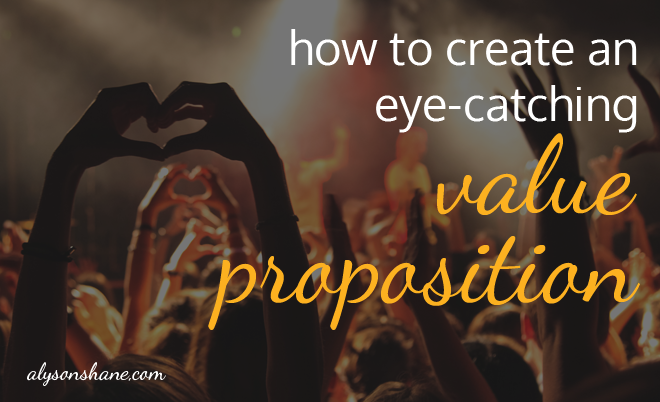
Understanding Your Value
This is tougher than it sounds. For many of us (myself included) our businesses happen as the result of a series of opportunities which may leave us feeling unprepared and confused. This is normal.
When I first started out I knew a few things: I knew what I loved to do (writing, content marketing, and community management) and I knew why my clients wanted to work with me (strong writing skills, good attitude, deep knowledge of my industry), but I struggled to clarify what the value of what those things actually meant to my clients. This takes some serious thought and reflection, and it's okay if you don't know right away.
Some things to ask yourself are:
- What am I exceptionally good at?
- What makes me and my business unique?
- What does a one-sentence summary of how I help my clients/customers look like?
Get to Know Your Ideal Client or Customer
Take a step back from your own train of thought for a second and think like your ideal client or customer, then ask yourself the following questions:
- What do they do?
- What kinds of problems do they have that I can help solve?
- How can my services or product help make their lives easier?
- What do they value?
Not sure how to answer these questions? Ask and do some market research! You can accomplish this in a variety of ways: conducting a Twitter poll, asking friends and colleagues, talking to your mentor - the sky's the limit!
Creating an Eye-Catching Value Proposition
Business is about being different. The more you can stand out from your competitors, the stronger your value proposition will be.
Here's what my value proposition looks like:
I help brands and businesses create long-term content marketing strategies which help them convey the right message to their target audience.
Let's break this down:
- I've identified the kinds of clients I want
- I've stated the kind of work I want to do (copywriting, content marketing, and social media management)
- I've described the kinds of working relationships I want (long-term ones)
- I tell prospective clients how I help them (increasing brand awareness and community growth)
Creating a value proposition which states what you do, what makes you different, and the kinds of clients and working relationships you want to have doesn't just tell your clients about what you do, but it also helps you determine if a potential client or customer is the right fit for you, saving you time in the long run.
Adding Social Proof

Do you have any accomplishments that you're proud of?
Maybe you were published in your local paper, received an award for excellence in your field, or spoke at a conference - whatever it is, feel free to weave these into your value proposition when you can.
This is called "social proof" and is designed to add to your value proposition in terms of concrete examples of how awesome you and your business are.
You can add things like "voted #1 in my field" or "nominated as 2015 Canadian copywriter of the year" - whatever it is (as long as it's true!) can go a long way to adding weight to your value proposition.
Now it's your turn!
Ask yourself what you want to do, how you'll do it, and how your approach makes you different than other people and businesses in your industry. Got questions? Leave them in the comments or drop me a line!
In My Community: SPIN (or, I saw the strangest play last night)
Last night, despite frigid temperatures and hostile winds, John and I trekked out to the Prairie Theatre Exchange to check out the opening night of SPIN, an unusual spoken-word, musical, theatrical oddball of a play featuring a string section, two guitars, a projector, and a bicycle as an instrument.
It was by far the weirdest play I've ever seen, and I totally loved it.
For those of you who don't know me personally, I'm obsessed with riding my bike. I first got into cycling as an adult when the guy I was seeing at the time and I purchased matching his & hers vintage road bikes for $40. They were named Vikki & Vance, and I loved them.
A few years later an unfortunate (car) accident led to me purchasing my current velocipede, Barbara Streisand, whom I now ride all over town the moment the weather allows it. I love cycling; it's an amazingly freeing and fun activity, and there are literally few things that I love more than riding my bike around on a warm day in the sunshine.
So, naturally when I was offered free tickets to see SPIN, a play about cycling, I jumped at the opportunity.

What's so good about a play about the bicycle?
What I didn't know about the bicycle before attending the play was this: the bicycle, in fact, was an important instrument for social change during the women's suffrage movement.
At the opening of the play, which is sort of a mash-up of ballads, catchy songs, and spoken-word pieces, Evalyn Parry emerges and does an impressive recital of Instructions on Learning to Ride a Bicycle, a pamphlet published by Miss Frances Willard, one of the most important suffragettes in history. After learning to ride a bicycle at 51 years old, she was so taken with this efficient mode of self-transportation that she wrote a pamphlet about it, declaring that "all women must all learn to ride, or fall into the sluiceways of oblivion and despair."
Wow. It definitely puts getting on my bike and rollin' around town feel a little less frivolous.
Not only are the stories that Parry weaves together hilarious, fascinating, and inspiring, but her vocals and guitar are backed up by... you guessed it, a bike. Brad Hart, Parry's accompanist who sports a fitting handlebar moustache, literally brings a vintage CCM bicycle to life by playing it like an instrument, suspended on a stand and connected to contact microphones.
The variety of sounds Hart can produce on a bicycle is, to say the least, a little mind-blowing. By using a combination of drum sticks, tuned bells, the spokes, frame, seat, and even the wheels themselves, he adds a unique and fitting element to Parry's songwriting.

The bicycle as an instrument of social change
SPIN is inspired in part by the amazing true story of Annie Londonderry, the first woman to ride around the world on a bicycle in 1894. Not only was 23 year old Annie Londonderry (not her real last name, Londonderry Lithia was a mineral water manufacturer who sponsored her ride) unusual in that she accepted this unusual challenge, leaving her three kids and husband behind in Boston, but what I found striking (and ingenious) was that she scheduled press events everywhere she went. She sold advertising space all over her clothes and her bike - what a hustler!
This is just one of the examples that Evalyn Parry uses to illustrate how important the bicycle became to women in the late nineteenth century; for the first time ever women had a quick, easy, and most importantly an independent method of getting around.
The bicycle did more than just give ladies a way to get around, however: it also changed the way that we dressed. Using Annie Londonderry as an example of this sartorial shift, Parry paints a hilarious scene of Londonderry riding into a city and blowing people's minds with her masculine attire and her penchant for not giving a damn about it, thank you very much.
"Taking your life into your own hands"
One of the recurring themes throughout the play is the idea that the rider is connected to the bicycle, and that it allows them the freedom to go where they want, whenever they want, on their own terms. Parry weaves the idea of using your heart to move yourself around on your bike, and the idea that the bicycle and all it represents is connected to you as you ride around, beautifully.
"Taking your life into your own hands" also has a double meaning, referring to the suffragette movement and women's rights. As Parry points out throughout the play women's rights are the result of women "taking their lives into their own hands" and not allowing it to be dictated by men, and that the bicycle was one of the first ways in which women were able to start asserting their own independence in stodgy Victorian society.
Two-wheeled words/to wield words
To be honest, when I agreed to see the play I didn't quite know what I was signing up for, but I certainly didn't expect a cabaret-style, spoken-word/musical history lesson on women's rights featuring a bicycle as a backup instrument.
More importantly, however, SPIN made me appreciate what it means to be able to put on my pants and hop on my bike to go do whatever I please. As a woman who gets to enjoy a lifestyle which is a direct result of the hard work of so many women before me, it felt good to have the opportunity to develop a deeper appreciation for something that I already love so much (cycling).
In fact, I was so impressed by the play that it made me want to pull Barbara our, slap some giant winter tires on her, and ride that girl all around town. And in the middle of a frigid Winnipeg winter, that's saying something.
SPIN runs at the Prairie Theatre Exchange until January 31st. Grab your tickets here.
Your Guide to Being Productive as Hell + a Free Daily & Weekly Planner!
It's the dead of winter here on the prairies, which means that lately I've been waking up to dark skies, chilly mornings, and basically battling the near-overwhelming urge to stay in bed like a big cinnamon bun.
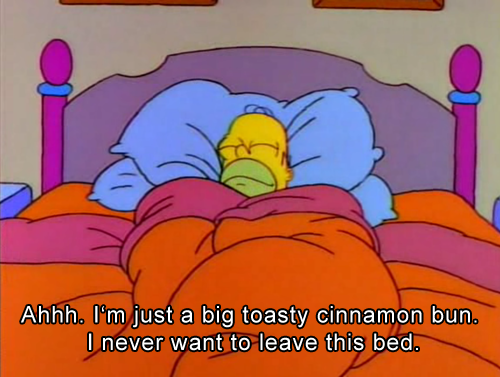
The summer months are my "power months." I find that, especially around this time of year as things get colder and darker, my productivity levels tend to drop. I feel much less inclined to sit at my desk and power through work, and my motivation tends to dip significantly.
Back when I worked in an office there were systems in place to keep employees motivated and on-track, which helped tremendously, but now that I run my own business I need spend the time to develop systems that fit my needs and help keep my motivated and productive.
That's what this post is about: productivity, getting shit done, and staying motivated.
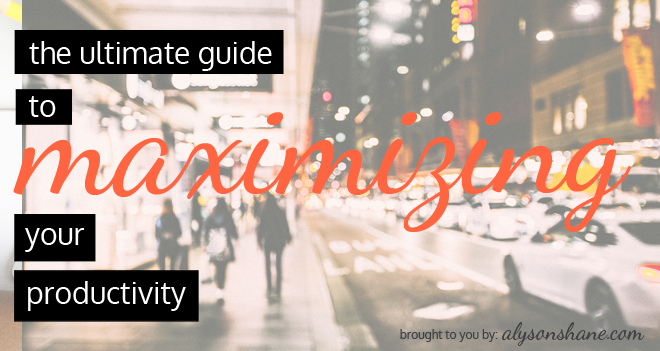
Some insight: what my days look like
Before I go too deep into what to do, let's take a quick look at what my day looks like, and how I make major dents in my to-do list every day:
Here's how my day usually looks:
- Wake up around 7, shower, make coffee
- I've recently started imposing a strict "no email" rule until after I get out of the shower. I used to read emails and find myself getting anxious at the time in-between getting ready and responding, and nobody needs that shit first thing in the morning. Now I wake up, shower, and mentally prep myself for my day before I check my emails. I also subscribe to Danielle Laporte's Truthbombs, which help me start every day on a positive, reflective note.
- Hit the gym
- I hit gym 2-3 times a week. I like to go in the mornings because it isn't as busy, and because I'm not a "morning person" I generally don't lose that much time where I would have otherwise been productive. I'm usually home around 9-9:30am.
- Check my email and read, respond to & file emails
- Once John is out the door (or I'm back from the gym, depending on the day) I park myself at my desk with my thermos of coffee and power through my email. Everything is responded to, taken care of, read/deleted, and filed away.
- Check off any "quick tasks"
- The first things I take care of are anything which take 15-20 minutes just to clear my plate. Generally this includes finding relevant content for clients, checking their messages/responding to new comments, reading any articles pertinent to what I'm doing, and scheduling a bit of my own content, too.
- Take care of my "priority tasks" first
- Once all my smaller tasks are complete I get to the most pressing task of the day; you know, the stuff that has a tight deadline that needs to get done. Because I know my productivity increases as the morning goes on, this usually starts around 10am and lasts uninterrupted until 1pm or so.
- Eat lunch and catch up on news
- I'm bad at taking breaks when I get into something, especially writing, but I try to make a point to stop and have a snack or some lunch in the early afternoon. I'll also take this time to read anything I have on the back burner, check Twitter, and walk around the house, harass the cats a bit, and stretch.
- Power through the other two or three "secondary tasks" on my to-do list
- Generally I try to leave really writing-intensive tasks for the afternoon, so most afternoons I spend writing content, working on blog posts for clients, or doing business-related projects.
- Set up my to-do list for the following day
- The last thing I do every day is review and write out my to-do list for the next day. That way I can sit down in the morning and see what my purpose-driven mind prioritized the day before.
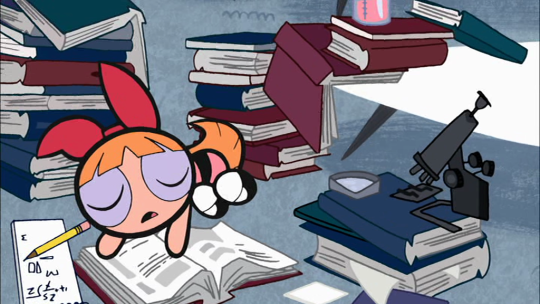
On any given day I work between 6-8 hours, though there are of course times when I go over, like if a client needs me to attend an event for them, or if there's a large project with a tight deadline. Sometimes, too, I just want to keep working, so I do!
I find that the days that I go to the gym are generally my most productive days. I that that this is because I'm doing something at the start of my day which requires 100% of my attention and focus, and gets my endorphins going.
Additionally, I definitely have days where I'm working like crazy, responding to a billion emails and phone calls, and spending all of my day doing things outside of my to-do list. That's normal. However, by slowly learning to optimize my time and allowing myself to develop a system that works for me, I can manage my time in a way that allows me to be super-productive without over-working myself and going crazy.
So now that you have a better idea of how I manage my day, it's time to start talking about how you can kick ass, take names, and maximize your productivity!
Track how you spend your time
I use Toggl religiously to help me keep track of where I'm spending my time each week. This goes for client stuff - I'm detailed down to which specific task I'm doing, and for which client - as well as my own business development. It can be hard to track for smaller tasks like responding to tweets or comments that pop up, but I do my best to keep track, and round it all up at the end of the week.
By reviewing my time and where it's going, I can identify things that take me longer than usual (scheduling lots of content in advance, reports, etc) and schedule in "distraction-free" time. I'm pretty good at managing this - usually having a separate window open with just the tabs I need to complete a specific task work for me, but if you need you can use products like StaFocused and Anti-Social.
Use the alarms in your calendar
I schedule everything into my iCalendar, and rely heavily on alarms which I set 20-30 minutes before I have to leave/be somewhere so that I can work uninterrupted, and actually focus on what I'm doing, rather than constantly checking the clock to make sure I'm not late.
I also use this to keep track of things like Twitter chats and Skype and phone calls, meaning I always know when a client is going to call, or when I need to be ready to moderate or participate in a chat. This means I can focus, distraction-free, on my work until right before I need to switch focus.
Set realistic expectations
This relates to my earlier point about tracking your time: understanding how much you can reasonably get done in a day, and letting go of the expectation that you have to be blindingly busy 100% of the time, can make a huge different not only in your happiness level, but also impact how productive you are. Worrying about being productive can actually make you less so because anxiety is disruptive and distracting.
With this in mind, take the time to track how much time it takes to do a specific task (eg: I know that a post of this size takes me about two hours to write/edit, not including finding and creating images) and organize your week accordingly.
Personally, I try to heap as much stuff on Tuesdays - Thursdays as possible, so that I can coast in and out of my week with smaller projects, follow-ups and the like. Plus, it's really hard to stay focused on a Friday afternoon when you work from home, you guys.

Treat yo' self
No matter what your job is I can pretty much guarantee that there's something about it that doesn't dazzle your senses. Whether it's writing reports, responding to emails, debugging a program... whatever, there's likely something that makes you feel less than stellar while doing it.
If you can't outsource it or get it off your plate, then I've found that the best way to motivate yourself to get it the hell done and off your plate is: rewarding yourself for your hard work, of course!
Basically you do this: "if I complete ______ (blog content, brand audit, etc) then I can _______ (watch the latest American Horror Story, have a glass of wine, go for a walk)."
I make a deal with myself in order to light a fire under my own ass and motivate myself to get it done, so that I can move on to the more appealing things I'd rather be spending my time doing.
Use weekly and monthly planners
Currently I'm using my iCalendar to keep track of all of my business and personal stuff - be that blog content, client deadlines, meetings, the #SocialHour Twitter chat, newsletters to send out... whatever I have coming up, it's in my calendar.
Sometimes it can be overwhelming to look at, but it means that I never miss a deadline, and I know exactly what I need to get done each day/week/month. However, if you find looking at a monthly calendar to be overwhelming (as I do) having daily and weekly checklists and to-do lists can go a long way in helping you stay on top of everything that you need to get done.
Want to get started on your organization and mega-productivity journey? No problem! When you sign up for my newsletter I'll send you an editable PDF Daily and Weekly Planner for you to save on your desktop and use every day, or (my favourite) print it off, laminate that SOB, and use cute markers to cross off those to-dos.
3 Things to do Before Breaking Out on Your Own
Well, I made it.
It's 2016, my business hasn't fallen apart, and my life didn't somehow implode in on itself. Yay!
Without a doubt, starting my own business and making the transition from being a full-time employee to a full-time business owner was scary as hell. There isn't really a "right" way to make the jump, and there aren't really a specific set of steps that you absolutely 100% must take in order to do it. However, there are a few key things to keep in mind before you break out on your own, which I want to discuss in this post.
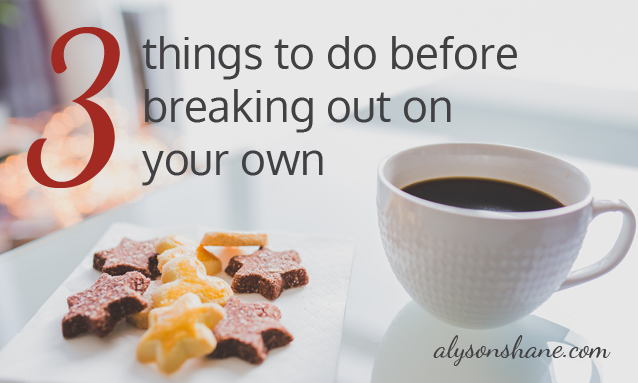
Why do I want to talk about this stuff? Because sharing is caring, and because I was lucky enough to have a wonderful and very clever guide (my boyfriend, John) who helped me navigate a lot of hurdles and helped me prepare for this experience.
Not everyone starting their own business is fortunate enough to have a John in their life, so here are a few things he taught me which I think will help you out if you think that running your own business is the path that you want to take:
1. Start Hustling Early
I got my first client a full year before I started working for myself full-time. Honestly, it happened by accident (I met a guy I knew from Twitter at a party who introduced me to his friend who needed a copywriter) and it wasn't for much, just a few copywriting articles each month. It didn't make a lot of money off that first client, but the experience of working with someone for a while helped me start to understand the dynamic of different kinds of working relationships which were different than the boss/employee relationship I was used to.
Also, starting small has allowed me to scale my business in a manageable way. I've acquired a handful of regular clients who I work with on a monthly basis, as well as some copywriting work, and one-off contracts for special events or websites as they come up.
I should also point out that I have been extremely lucky. What happened to me isn't always the case, and it's not realistic to assume that just because you go into business for yourself, that clients will start pouring out of the woodwork right away.
Not just that, but securing an ongoing contract (if that's what you're looking for, some businesses operate on a per-contract basis) often takes time. The process from the initial email or meeting to signing a contract can take months to happen, or never materialize at all.
By starting to build a client base early, you can get a feel for whether or not running your own business is actually what you want to do before you jump feet-first into doing it. Also, leaving your secure 9-5 knowing that you already have a handful of contracts to take care of your living expenses goes a long way in helping make the transition less scary. Trust me on this one.
2. Buckle Down
Assuming that you're working a 9-5 job in addition to building your business, you're going to be insanely busy trying to juggle both before breaking out on your own. Get used to it.

Before I left my office job I was working most weeknight evenings from 6-11 or 12, and spending a lot of time working on the weekends, as well. If you're trying to build up a decent client base to help you make a smooth transition, then obviously any time spent doing that work needs to be done outside of regular office hours (unless your boss is cool with this, which most aren't.)
If you want to work for yourself, you need to get ready for a very imbalanced work/life lifestyle for a while. Not just before you leave your 9-5, but afterward, too. To illustrate: I'm writing this on a Sunday evening, after working all day since I got up. I've also been on "holiday" since Christmas Eve, but have spent at least 5 days of my 10-day 'holiday' working for the majority of the day (who told you that running your own business was glamorous?)
What's crazy is that what I just illustrated isn't that uncommon; lots of people I know work even more than I do! But when you run your own business you're the only person responsible for generating your own income, and the sooner you get used to working aggressive and unusual hours, the better.
3. Save Up
Without a doubt the most terrifying thing about working for yourself is the transition from going to having a regular paycheque which is deposited into your bank account every two weeks, to one where your financial situation is in a state of flux.
I try not to talk too much about my financial situation, but in the interest of learning from my experience, here's how I managed to get myself into a relatively good position:
When I got my first contract (the small copywriting one I mentioned earlier) I used it to start paying down my credit card debt and the student debt that I'd acquired while in university. As I picked up more clients and started to think more seriously about running my own business as an option, I started splitting my additional income (ie: the money I was making above what I was paid at my office job) between paying down my debt and putting it aside in a nest egg.
Having a nest egg allows me to not freak the hell out when a payment is late (which happens) because I still have a float to live on for a while. Honestly, this "float" is the key to running your own business and not being in a constant state of panic. This all changes when you start bringing subcontractors and employees into the mix, of course, because they have to be paid before you do, but that's a whole different kettle of fish (and anxiety) that we won't go into here.
One last thing about money: get your taxes in order. If you live in Canada and you run a business making over $30,000/yr you must register for a General Sales Tax (GST) number. Dealing with the Canada Revenue Agency is a hassle (believe me) but if you aren't filing your taxes correctly you can wind up owing tens of thousands of dollars. Speak to your bank or accountant, if you've got one, and make sure you're covered.
Do you have any tips for people thinking about breaking out on their own? Tell me in the comments!
How to Create an Eye-Catching Media Kit
One of the easiest ways to set yourself apart from your competition and impress prospective clients and customers is by having a strong media kit.
A media kit is essentially a tszujed-up version of a traditional resume, except without all the boring stuff. Instead of a lame-looking page listing some roles you had at old jobs, a media kit is a way for you to present what your brand is all about. It's designed to share your story, your services, how you help your customers and clients, samples of your work, testimonials, and businesses you've helped succeed or collaborated with.
In this post, I'll walk you through an in-depth explanation of what a media kit is, why you should use one, and how you can create one that helps your brand stand out from the rest.

What is a Media Kit?
A media kit is a collection of information about your brand which helps potential customers and clients understand who your brand is, what you do, and what makes you different than your competitors. A media kit can come in variety of flavours, but since I use (and have experience creating) print PDF media kits, this style is the one that I'll focus on in this post.
Basically a PDF media kit looks little a booklet, with a cover page, index (if necessary), and sections breaking dedicated to different topics. The core of your PDF media kit should be a description of your brand and your values, bios of you and your team (if you have a team), your services, and some supporting stuff (testimonials, case studies, etc) that backs up how awesome the rest of your media kit says you are.
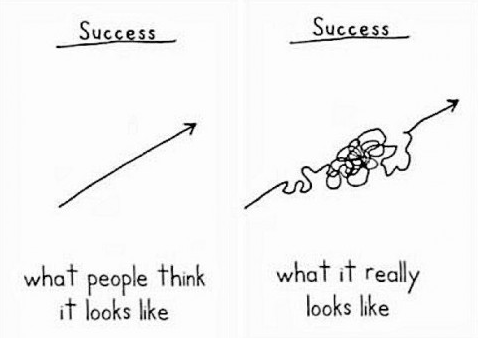
Why Do You Need a Media Kit?
A media kit makes you seem more professional. The fact that you've clearly put the time and effort into producing something which effectively conveys your brand, your values, and what you do shows that you've actually thought this shit out.
The idea of a good media kit is that it introduces your brand better than you can. Unless you're a master speaker who carries a Keynote presentation around in your pocket, a PDF with choice words and eye-catching visuals can easily summarize what you do and give potential clients an overview of your company much easier than you can.
Creating an Eye-Catching Media Kit
How your media kit looks is just as important as what's inside. If your media kit looks like you printed it out at a Staples using the black and white printer on the way to the meeting, nobody's going to take you seriously.
Here are some things to keep in mind to create a concise, clever, and cute (okay, maybe not cute but I like alliterations) media kit which will blow your competition out of the water:
- Avoid blocks of text whenever possible - bullet points are your friend!
- Keep it short. 3-10 pages is ideal for keeping someone's attention.
- Be consistent. Use the same colours, font and branding that's on your website and business cards.
- Don't use more than two fonts. If you can match them to the ones on your website/cards, even better.
- Use images whenever possible; people's eyes start to glaze over and this helps break things up.
- Never misrepresent information or work you've done.
- Update it as necessary. Taking the time to keep it updated shows you're serious about acquiring new business.
What to Include in Your Media Kit
Basically you want to start with the most basic information as possible, and build on it from there to things which get more specific and particular to your industry. Below is a rough outline of the things that you should include, or should consider including, in your media kit.
Remember, these are unique packages which should convey who you are. If any of these things below seem weird, or not like a fit with your business or how you want to present yourself, then feel free to nix them as needed.
1. Who You Are
This section is designed to, obviously, introduce you, your brand, and your team. It should include:
- Your logo and branding.
- An About section. Introduce your brand, how it got started, your primary market, and what motivates you to do the work that you do.
- 'Who I Am' or 'Meet the Team' section with head shots and short bios. Bios can include experience, skills, knowledge, and what each team member contributes, if needed.
- Your target market. Take a moment to describe the kinds of businesses and brands you work with, and in which fields.
2. Your Services
This section is pretty straightforward. List the kinds of services you offer, and provide examples if possible. What's great about this section is that it allows you to define what you want to do, not the other way around. This is how a media kit is different on a resume: on a resume you're basically trying to state a variety of stuff you think people will want to hire you for, whereas a media kit, though intended for the same purpose, doesn't require you to offer up a service you don't want to do, or aren't skilled at doing.
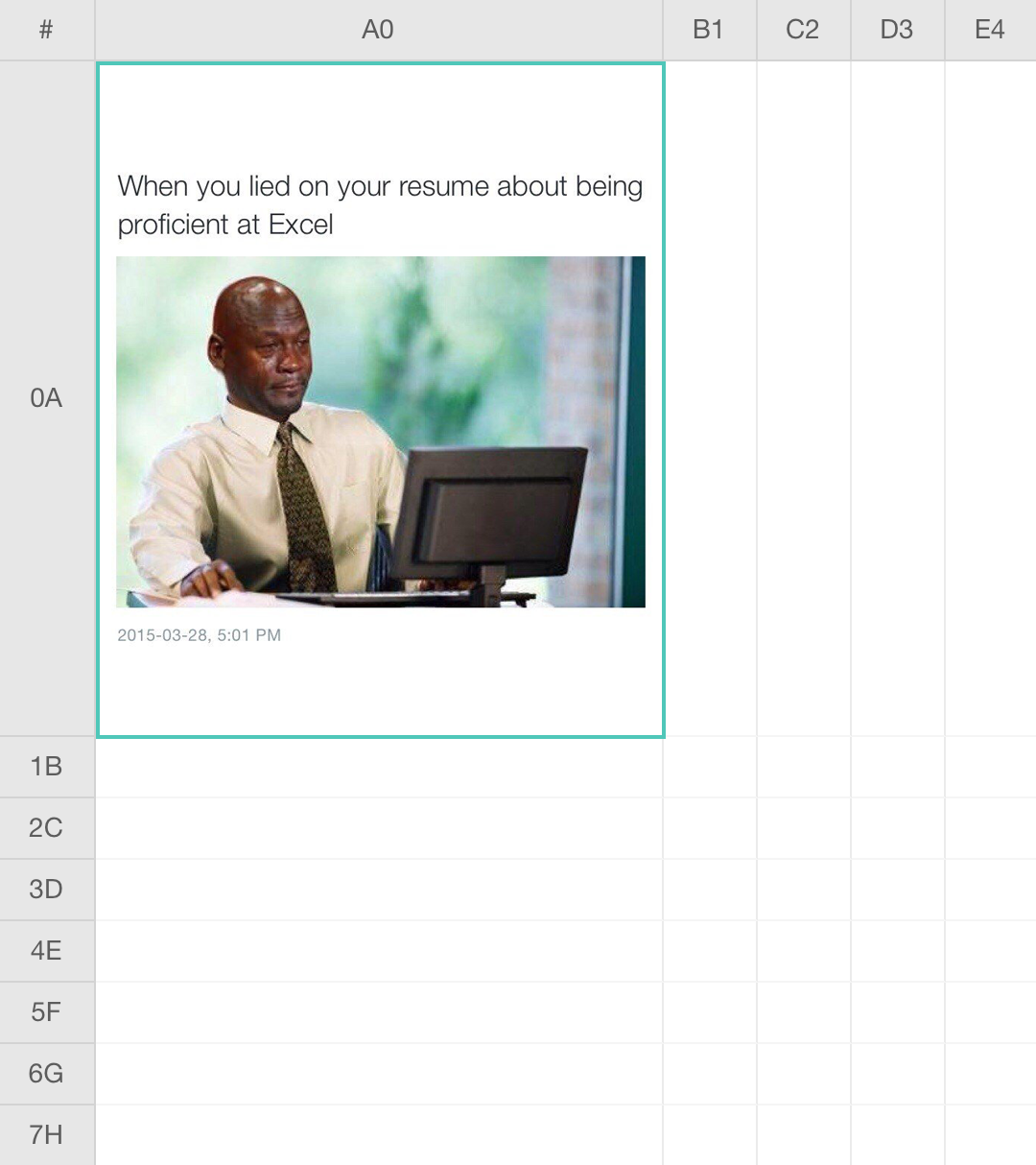
Below is a copy/paste from the Work With Me section on my website. Basically my media kit has a similar iteration to this:
Some Ways That I Can Help You
I'll start by asking questions and help you figure out:
- Who and where are your audience?
- What are their needs and how can you help fulfill them?
- What is your brand message?
- How can we convey this clearly and simply across multiple online platforms?
- Which platforms will help you create a community around your brand?
3. Pricing
This is totally optional.
If your pricing varies from project to project (as mine does) then it may not be advantageous to include a pricing sheet. Personally, because of the amount of setup and customization involved with managing a content strategy across a variety of platforms, I prefer to quote projects on an individual basis.
However, if you're comfortable with sharing your rates from the get-go, or do work which can be easily billed hourly (like graphic design, for example), feel free to include this section in your media kit.
4. Portfolio
If you've been in business for a while, it's often helpful to include other examples of work you've done for past or current clients. This can include case studies, examples of work you've done, or even a list of logos from brands and businesses who have worked with you in the past.
Photographs work wonders in this section, so if you're able to show examples of what you do in screenshots, beautiful images, or in infographs, this is the place to showcase it.

5. Accomplishments
This is also the area where you can share other successes and accomplishments which give your brand more credibility. Some good examples of accomplishments to include are:
- Conferences who have invited you to speak
- Interviews you've done
- Articles published about you
- Websites or sources who have republished, re-shared, or references your work
- Awards you may have received
- etc
6. Testimonials
This goes without saying, but having a strong testimonial's page can go a long way to adding to your credibility. A testimonial from a customer is basically them saying: this person/brand did a good enough job on the work they did you us that I'll put my name behind supporting them in their future endeavours.
7. Policies
This is another area which you can either include, or not. Conventional wisdom (aka a lot of sites I looked at back when I was building my media kit) suggest it, but to be honest I don't prefer to get into stuff like specific policies until a prospective client and I are ready to sign a contract.
This is just personal preference, but bringing legalese and policies in at a very early stage doesn't give me the warm fuzzies about working with someone. I prefer to discuss things first, and then finalize them in the contract before we begin working. Again, this is just personal preference!
Make it Personal
The most important thing about your media kit is you. The whole purpose of this lovely, slightly stress-inducing to create little package is to convey you and your brand in all you glory, so make sure to include a little bit of sass or personality in there somewhere. People want to feel like they're putting their faith (and funds!) in real, down-to-earth professional people, not weird robots who take themselves too seriously.
Media Kit Template Resources
I created a custom media kit for myself using Pages, but if you're not a super-creative type, or the idea of dragging boxes around and aligning text sounds dreadful, check out a few websites offering inexpensive (or free!), trendy AF media kit templates:
- Turner Media Kit Template via HipMediaKits
- Media Kit Template via FoodBloggersCentral
- Media Kit Template via LifeYourWay
- The Minimalist Media Kit via ZaniFest
- The Brand Magnet Media Kit Template
Was this instructional helpful? Let me know me in the comments!
5 Things to Let Go of in 2016
Okay, I know how cheesy these posts are, but bear with me!
I've had a transformational 2015: I started running my business full-time; I started a second business (more on that soon!); I was awarded a TechFutures Grant; I met so many amazing people and had experiences that the Alyson of 2014 wouldn't have had the guts or ambition to go after.
I also know that there will be tough years ahead, sometime in the nebulous, unknown future, which is why it's important to reflect and consider the things to improve on, and the things to let go of.
With that in mind, I'd like to share my reflections some of this stuff with you guys:

1. Let go of everyone's opinions of your life
There are always going to be people who are going to give you their opinion of how you should be living your life, and that's okay. However, you need to keep in mind that there's no one "right" way to live, and that happiness can mean a variety of things for a variety of people.
Unfortunately this means that you can't please everyone. Your definition of a successful and happy life may be drastically different than someone else's, and they may not be afraid to loudly tell you so. This can get discouraging, and in my experience often leads to self-doubt, and in extreme cases to indecision and stagnation instead of progress. This is because when you spend all your time defending your decisions to other people, you stop focusing on making the best choices.
Ask yourself: what kind of life do you want to have? Do you want a traditional 9-5 with a cute house and a lovely spouse? Do you want to jet set across the globe, live in hostels and take a series of lovers? Maybe you want to do something else - that's okay! What matters is defining what your ideal lifestyle looks like, and then taking steps to achieve it, no matter what anyone else thinks.
2. Let go of your comfort zone
A few weeks ago I spent the day at InnovateMB's Pitch'Day workshop and - full disclosure - initially I did not want to go. Not because I didn't think the workshop wouldn't be super-helpful (and it was!) it's because the idea of having to sit by myself in a room full of my peers and present, discuss, and analyze my business idea scared the living daylights out of me.
However, after a cup of coffee I pretty quickly found a better attitude and wound up learning a ton - way more than if I had held on to my discomfort. Instead, I made a point to actively participate, ask questions from the presenter and engage as much as possible, and I wound up having an excellent time!
Not just that, but pushing myself that way felt good. Even when I got something wrong, or made a mistake, I could let myself off the hook because at least I got over myself (and my fear of being wrong) and made an effort.
This is of course easier than done in a lot of cases, but taking baby steps like asking a question, going out to a meetup where you don't know anyone, or even taking yourself out for lunch can make a huge difference in how you feel about yourself!
3. Let go of 'Zero Days'
I read a great post on Reddit yesterday which discussed being motivated and staying positive, and one of the things they mentioned was not allowing yourself to have 'Zero Days'. A Zero Day, according to /u/ryans01, is "[a] day is when you don't do a single fucking thing towards whatever dream or goal or want or whatever that you got going on."
Look, I hear you: "Alyson, asking me to never take a day off is ridiculous!" Which is true. Good on you for recognizing that over-working yourself is counter-productive!
However, taking baby steps each day towards your goals is a totally within reach! Here are a few examples of things I do so that I don't have Zero Days:
- Write blog posts/sketch out content ideas
- Work on the Crowdfunding Crash Course eBook, Puffin Chat, and other side projects
- Read articles about my industry and the tech sector
- Queue up content for my/client's social feeds
- Go to the gym and work out
- Clean and listen to podcasts (I find a clean house helps me think & focus)
- Draw or doodle in my sketchbook
Notice that all of these things are pretty low-key and don't really seem that taxing, which is the beauty of it. All of these things, if done consistently over time, will help me work towards my goals (being creative, moving my business forward, staying in shape, working on my art, etc) and if I look at them as small things to do each day they feel a lot more manageable.
Full disclosure: I still have zero days. Usually they look like days where we lie around on the couch, order some SkiptheDishes (I'm hooked) and binge-watch a TV show (we just finished Jessica Jones - so good!) but they are few and far between, and are getting further and further apart.
4. Let go of the people who don't add value
This is the one of hardest things.
It's so easy to let people over-stay their welcomes in our lives. Whether it's an old lover who doesn't ignite your heart like they used to, or an old friend who doesn't zhuj up up your days, sometimes we let people who should have parted ways with us stay around too long. Sometimes (too often) we even fight to keep them in our lives because they've become familiar and comfortable.
But it's important to do our best to consistently re-evaluate the people we devote our time and energy to. Like the old adage goes, we are the sum-total the the five people we spend the most time with.
Ask yourself: how do I feel around these people? What do we talk about - are they generally negative, or positive topics? Do these people make me feel small and insecure, or unafraid and bold? These are important questions to ask on a regular basis, and if someone starts to fall into the negative category for too long, it's time to have a chat about it, and potentially move on.
5. Let go of the idea that you can't change things
You can always change. If there's anything that the past few years have taught me, it's that a few small changes, or a little bit of belief in yourself can make a world of difference.
The problem with looking towards the future is that the future feels overwhelming. So instead, try to take baby steps (see Zero Days above) which help you work towards your goals at a pace that feels comfortable. Here's a personal example:
When I was 21 worked a safe government accounting job, but I was unhappy and wanted to go to university. However, quitting my job was scary and I didn't know if it was the right choice. I hummed and hawed for weeks about what my next steps should be. I felt overwhelmed at the transition from full-time employee to full-time student, and how to get started. However, I knew how, deep down: I needed to call Student Central at the university and book an appointment to speak to someone about pursuing the degree I wanted.
It was so easy to find reasons not to call and speak to someone about applying: I went out on my lunch break and there was no time; I felt too busy and overwhelmed from my workday to deal with it; and, most commonly "I just don't feel like it today." One day, though, I picked up the phone and did it. I spoke to someone, got the information that I needed, and after I hung up the phone I distinctly remember saying to myself "wow, that was so much easier than I'd made it out to be."
Spoiler alert: most things are easier than we thought they'd be. It's just a matter of looking at things as small steps towards a larger goal, instead of huge, overwhelming obstacles. Chip away at it slowly and you can move a whole mountain, if you try!
What are you letting go of in 2016? Tell me in the comments!
How to Work From Home & Not Go Crazy
Last week, after nearly 6 months of working from home, it finally happened: I got lonely. Not just any kind of lonely, though, this was "it's Tuesday and I haven't left the house or talked to the outside world since Sunday" kind of lonely. I started to feel anxious, crazy, and totally disconnected from the outside world.
As someone who has worked in an office for the majority of their adult life, working from home has taken some getting used to. Don't get me wrong, the perks are endless: I can wake up when I want, I can go for lunch or coffee with a colleague and not worry about being back "in time", and I can plan my workdays around when I'm my most productive and not when a boss expects me to be.
However, it does get super lonely. Hanging around the house all day with these two weirdos is awesome, but it's weird how much you begin to miss that water cooler chit-chat, and how much effort actually has to go into making sure you don't drive yourself stir-crazy.
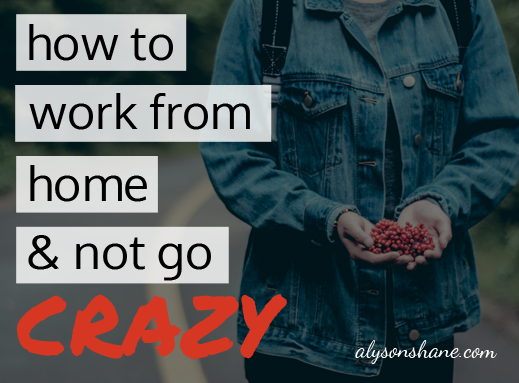
Get Dressed
Getting dressed is the difference between a "lazy Saturday in front of my laptop" and "I'm getting actual work done" mode. it might sound crazy, but stick with me here, there's some important reasons why this is actually a helpful and totally legitimate practice:
Clothes are symbolic, and affect how we feel about ourselves. When you put in the time to make yourself look nice you're more motivated to "get out there" and hustle, whether that means meeting a client, going somewhere, or even talking on the phone. In addition to that, getting dressed helps subconsciously compartmentalize areas of your life that can begin to blend together when you work from home.
Besides the mental difference between hanging out in your PJs and getting dressed, being fully dressed and ready to head out the door means that you can do exactly that - I can pop out to the store, to grab a coffee, or to go sit somewhere and work if I feel like it.
Personal aside: I have "power lipstick" that I put on before an important client call. I know it's silly, but wearing it makes me feel like a bombshell badass à la Meryl Streep in The Devil Wears Prada and definitely makes me feel more powerful and assertive.
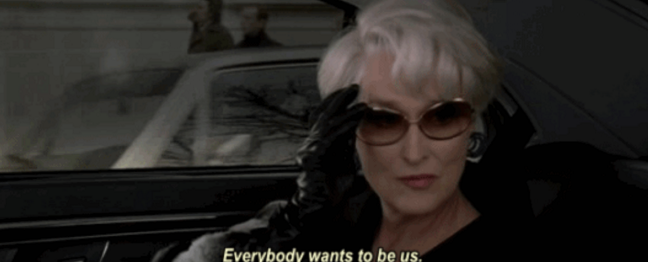
Keep Your Work Area Separate
Disengaging from work mode into relaxing mode is way harder when you do both in the same space.
Currently I do all of my "office" work at my iMac, at a desk, in a computer chair, and try to relegate "downtime" (aka hanging out on social networks, reading for leisure, and writing) to sitting on the couch with my Macbook. Sometimes these lines blur - I'll work on my eBook from the couch, or write a blog post at my desk (like I'm doing now) by and large my 9-5 type work takes place at a separate area than my leisure time.
My guess is that it's a mental thing, but sitting on my super-comfortable couch with my feet up makes me feel less like I'm working... so I work less. I spend way more time slacking off if I try to work from the couch than if I'm art my desk. Additionally, I can "leave work" for the day by putting my iMac to sleep and shutting off my desk lamp - those are symbolic gestures that, for me, signal the end of my workday and a transition to hanging out and relaxing.
Figure Out When You're Most Productive
One of the biggest changes from going to working in an office to working at home is that you don't have to worry about being "on" all the time. What I mean by that is, you don't have to worry about looking busy 24/7 just in case your boss happens to walk by and see your screen. According to a salary.com article from 2014, 89% of employees say they "waste time" at work - whether that's checking their email, hanging out on Facebook, or loitering around the coffee machine; they're not sitting at their desks and being productive.
But what does "productivity" mean? For most employers, it means that you're plugging away at a task and that you're operating at the highest efficiency levels from the moment you arrive to the moment you leave the office. Realtalk: this just isn't the reality, and sitting at your desk and forcing yourself to try and operate at maximum efficiency all day is a surefire way to get next to nothing done.

One of the great things about working from home is that you can set your own schedule according to when you're most productive, rather than trying to be productive all day (which rarely happens with any real level of consistency - we all need breaks, after all).
I know that I'm most productive early in the morning (8-11ish) and late in the afternoon (3-6ish), with a lull in-between most days, so I tackle my most pressing and important tasks during those two times - usually I try to handle client stuff in the AM, and do business development stuff (blogging, writing my ebook, etc) in the afternoon. That way I know I can get the most out of my day, and by having a little downtime I can make sure when I'm productive I'm as focused as possible.
Declutter Your Desk
Clutter is the enemy of productivity, and if you have to spend a ton of time searching through papers, looking for a pen that works, or rooting through old notes and files you're distracting yourself from what you should actually be focusing on: being productive.
I'm a bit of a cleanliness nut, so here's how I keep my desk organized and in a state of zen during the week:
- I only use one pen at a time. Actually, I rely pretty heavily on mechanical pencils, but I have a little box that I got from Magic Pony several years ago where all my pens and pencils live.
- Do a paper purge. I try to keep my desk as paper-free as possible, which means rounding up notes, papers, and receipts and putting them away. Additionally, if you want to claim something on a receipt as a business expense take a photo before you put it away. I do this weekly and it saves me so much hassle.
- Purge your desktop. Put unused files or photos in the trash bin and try to keep your computer desktop as clutter-free as possible. I generally only have my notebook, a pencil, and my phone on my desk when I'm working.
Find Reasons to Leave the House
This is a huge one, kids. It's way too easy to wake up, work, hang out, go to sleep, wake up, work, hang out, go to sleep, wake up... you get my drift. Especially during the winter months when sitting outside on the deck isn't an option it can be all too easy to wind up staying inside for days at a time, ordering all your meals in from SkiptheDishes and being glued to the computer screen.
Personally, I combat this by hitting the gym on a regular basis, which gets me out of the house, on the bus, and interacting with other human beings 3-4 times a week. Usually I'll stop by the grocery store on the way home for a little more face time with people aren't my boyfriend or my roommate or his girlfriend.
Don't Work in Bed
This should be self-explanatory, but just in case: don't bring your work into the same place where you sleep and snuggle up with your lover.
Do you have any tips for staying sane while working from home? I'd love to hear them!
Content Marketing vs Social Media
One of the things I find myself discussing again and again - with clients, friends, colleagues, and people who are genuinely confused about what I do, is the difference between "content marketing" and "social media."
Usually when I tell people I do content marketing and social media they respond with something like "oh, you just publish stuff on Twitter, right?" which is really only a small sliver of the equation.
While content marketing heavily involved social media, there's much more to creating content than just pushing it out across a variety of social channels. Even though there's a lot of overlap they are, in fact, two very distinct things, each with different goals, strategies, and processes.
So, once and for all, let's clear the air!

The Sun and the Solar System
Social media marketing is the focus of your marketing activity which is located on social networks.
When marketers share content on social networks like Facebook, Twitter and Pinterest, they're operating within the specific confines of those networks. Sure, they're sharing their own content in a lot of cases, but it's on someone else's network, and none of those networks connect to each other all that often (eg: you don't share Tweets on Facebook, and vice-versa.)
Conversely, the centre of every content marketing strategy is the organization's website.
A business' website is designed to be the central place for all of their branded content. Once the content has been published on the central website, it gets shared across the various social networks where the company has a presence. So, "social media" is the act of using specific social networks, and "content marketing" is creating content on your own website to be published and distributed.
The way that I like to describe this process is the "Sun and Solar System." In this example, your brand website is the 'Sun' - the focal point in all of your marketing efforts, and the brightest and most important star in the sky. The other social networks that you use to distribute the content are 'planets' which orbit around the central hub. Like planets in real-life, the 'planets' in this example operate independently of each other, all have unique features, and have one thing in common: they exist because of the 'Sun'.
Types of Content
Social media marketing is designed to fit within the confines of that social network. For example, a Tweet on Twitter needs to be 140 characters or less, Pinterest pins need to have eye-catching photos, etc.
Content marketing, on the other hand, can come in a variety of styles, flavours, and lengths because websites allow for much more creative and extended types of content. On a website brands can publish blog posts, videos, infographics, white papers and eBooks... the sky's the limit, really.
This flexibility in content means that brands can exercise a higher level of creativity in the content they create on their website, because they don't have to worry about falling within a 140 character limit.
Goals
While content marketing and social media marketing are used in tandem to reach specific goals, they actually are designed to achieve two different things:
Content marketing is focused completely on the 'Sun', which allows it to focus more on demand generation and content publishing than on getting the word out about it.
As a brand publishes content on their website, the 'Sun' in the middle of their solar system, they can use social media to direct traffic back to it, developing a relationship with their audience.
Social media is used to promote brand awareness. When a visitor lands on a brand's website, the brand has full control over what kind of experience that visitor is going to have, and they already have the advantage because the potential customer has already indicated interest by going there in the first place.
Because social networks can't be controlled by brands and businesses, the purpose of those networks then becomes to use them as a means to generate discussion and interact with their audience. Additionally, because social networks are mostly democratic (I say 'mostly' because of the recent introduction of YouTube Red) and all user account are created equally, social networks become a place for brands to have informal interactions with their audience.
Social networks also notify you when someone is talking about you, which makes tracking customer mentions, feedback, and criticism a lot easier to track than ever before.
Why Content Marketing?
Content marketing and social media go hand-in-hand, but many people I talk to focus only on the social media side of things because seeing a brand's presence across multiple social networks gives the impression that it's more important.
This is not true, and I'd actually argue that content marketing actually the more important of the two.
That's because in order for your social media feeds to have a way to genuinely connect with your audience, there has to be a central 'hub' (or Sun) at the centre of things to drive brand awareness and help craft a story. You can't tell your audience about who you are if you don't create the kind of content that helps them understand and care, and social networks just aren't as efficient at doing it because you have to play by the rules of each specific network.
This is why content marketing and social media marketing, though two different things with different purposes, are actually intricately linked.
Did this explanation make sense? What do you think about the difference between content marketing and social media? Tell me in the comments!
In My Community: Butcher
The most important stories are the ones which make us uncomfortable. The ones which force us to take a long, hard look at ourselves in the mirror and ask "what would I do? How would I react?" and then grapple with the response.
Butcher, a play by Canadian playwright Nicolas Billon, which is currently showing at the Prairie Theatre Exchange, is an example of modern storytelling which forces that kind of brutal, disturbing introspection.
Full disclosure: I was offered these tickets by the PTE in exchange for writing this article. I want to point that out because I want to be honest with you guys about when I get something for free, and also because I want to point out that what I'm about to say was in no way influenced by their offer. I was blown away by this play, and can't say enough good things about it.

A brief overview
Butcher is a play which starts with an old man who shows up at a police station wearing a military uniform, a Santa hat, and a meat hook draped around his neck. He doesn't speak English, but he's got a lawyer's business card stuck onto the meat hook with the words ARREST ME written on it.
Then, a series of scenes begin to unfold inside a single room between a detective, a translator, the lawyer, and the old man, which explore ideas around justice, vengeance, genocide, and forgiveness.
The play is full of twists and turns, and many times I found myself gripping my seat in anticipation. I don't think a play has ever moved me, or made my heart pound as hard in fear, as Butcher.
What makes it good?
I know I just said I wasn't going to spoil anything, but this one is necessary to actually review the play: the old man turns out to be "the Butcher, " a war criminal who ran a concentration camp during a civil war in the fictional country of Lavinia. The Butcher is wanted by two groups: Interpol, and a group of rebel survivors called The Fjurioji, or the Furies.
Butcher is comprised of a series of conversations about the brutalities of war, the kinds of inhumane things that humans can do to one another, and the cycle of violence that is continually perpetuated by hatred and revenge. It explores these ideas so deeply, and in such a visceral and compelling way that I found myself moved to tears or squirming in my seat on several occasions.

One example is when the old man is forced to confess his worst war crime. Most of what his character says is translated through the other characters, but in this case, as he describes his horrific, brutal actions, the audience can only rely on the reactions of other characters to interpret the severity and brutality of his actions.
This scene, where the audience was left to imagine the atrocities committed by a war criminal, was just one of many where I found myself cringing and feeling uncomfortable. It also served to illustrate how far-removed most Canadians are from the atrocities of war: even when someone is spelling them out for us, we still can't manage to comprehend what those experiences are like. It's like they're speaking another language.
Moving & thought-provoking
Lately it's hard not to feel like the whole world has become engulfed by fear and anger. From the recent Paris attacks, to the deplorable comments being shared across social media about Muslims and the Syrian refugees, it's terrifying to see how easily fear can enter our hearts, and stay there.
Butcher shows us how easily we can become consumed by our lust for revenge, and how even the most innocent among us can become twisted, mutated versions of ourselves when subjected to enough horrors and traumatic experiences. That when we treat others with hatred and fear, those people become permanently damaged or broken by it, and can only turn to more violence and hatred to try and fill the hole that our actions carved in them.
This idea, that the cycle of violence is a self-perpetuating process than can only be halted with deliberate kindness and forgiveness, was a powerful message which, I think, couldn't be more relevant to current global issues. Fear and division are powerful manipulative tools, and we have a responsibility to try and act better than the people who have mistreated us, or acted with hatred in their hearts.
With that in mind, I highly recommend that everyone check out Butcher while they can (it's running at the PTE until December 6, 2015). You won't be disappointed.
**I'd like to thank the Prairie Theatre Exchange once more for providing me with tickets to see this outstanding play. I was moved and humbled by Butcher, and can't recommend it enough.


